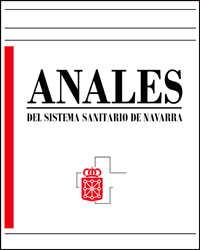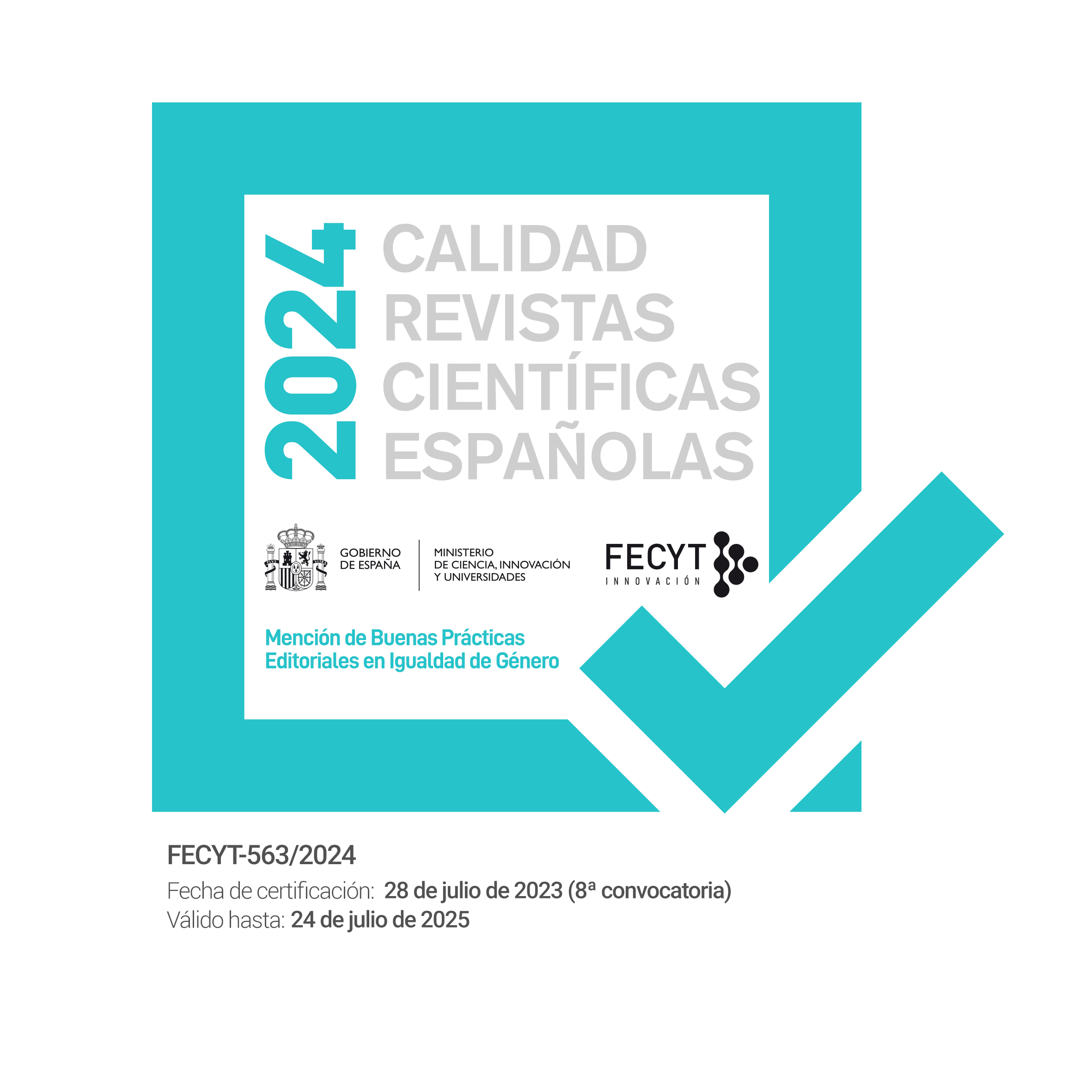Higiene con clorhexidina en unidades de cuidados intensivos para prevenir infecciones nosocomiales. Revisión sistemática
DOI:
https://doi.org/10.23938/ASSN.1027Palabras clave:
Unidades de Cuidados Intensivos, Clorhexidina, Baños, Higiene, Infección hospitalariaResumen
El objetivo de este estudio fue conocer la efectividad de la higiene con clorhexidina para prevenir infecciones nosocomiales en pacientes adultos ingresados en unidades de cuidados intensivos (UCI). Se realizó una revisión sistemática de los ensayos clínicos aleatorizados publicados en los últimos 10 años en diferentes bases de datos. Se extrajo información sobre distintos tipos de infecciones, mortalidad, y microorganismos implicados y multirresistentes.
Se incluyeron cinco estudios. La intervención no fue efectiva en dos estudios debido a una baja frecuencia de infecciones y a una alta prevalencia de bacterias gramnegativas, frente a las que la clorhexidina no es tan eficaz. La intervención tampoco redujo las tasas de mortalidad. La intervención fue efectiva principalmente para prevenir bacteriemias e infecciones por bacterias grampositivas, por lo que podría ser útil en las UCI con altas prevalencias de infecciones de esas características.
Descargas
Citas
World Health Organization. Report on the Burden of Endemic Health Care-Associated Infection Worldwide. Ginebra: WHO, 2011. https://apps.who.int/iris/bitstream/handle/10665/80135/9789241501507_eng.pdf
BOEV C, KISS E. Hospital-acquired infections: current trends and prevention. Crit Care Nurs Clin North Am 2017; 29(1): 51-65. https://doi.org/10.1016/j.cnc.2016.09.012
BOEV C, XUE Y, INGERSOLL GL. Nursing job satisfaction, certification and healthcare-associated infections in critical care. Intensive Crit Care Nurs 2015; 31(5): 276-284. https://doi.org/10.1016/j.iccn.2015.04.001
AL-DORZI HM, ARABI YM. Outbreaks in the adult ICUs. Curr Opin Infect Dis 2017; 30(4): 432-439. https://doi.org/10.1097/QCO.0000000000000387
GOULD DJ, MORALEJO D, DREY N, CHUDLEIGH JH, TALJAARD M. Interventions to improve hand hygiene compliance in patient care. Cochrane Database Syst Rev 2017; 9(9): CD005186. https://doi.org/10.1002/14651858.CD005186.pub4
ZARAGOZA R, RAMÍREZ P, LÓPEZ-PUEYO MJ. Infección nosocomial en las unidades de cuidados intensivos. Enferm Infecc Microbiol Clin 2014; 32(5): 320-327. https://doi.org/10.1016/j.eimc.2014.02.006
MAGIORAKOS AP, SRINIVASAN A, CAREY RB, CARMELI Y, FALAGAS ME, GISKE CG et al. Multidrug-resistant, extensively drug-resistant and pandrug-resistant bacteria: an international expert proposal for interim standard definitions for acquired resistance. Clin Microbiol Infect 2012; 18(3): 268-281. https://doi.org/10.1111/j.1469-0691.2011.03570.x
EDWARDSON S, CAIRNS C. Nosocomial infections in the ICU. Anaesth Intensive Care Med 2019; 20(1): 14-18. https://doi.org/10.1016/j.mpaic.2018.11.004
TRUBIANO JA, PADIGLIONE AA. Nosocomial infections in the intensive care unit. Anaesth Intensive Care Med 2015; 16(12): 598-602. https://doi.org/10.1016/j.mpaic.2015.09.010
BURGMANN H, HIESMAYR JM, SAVEY A, BAUER P, METNITZ B, METNITZ PGH. Impact of nosocomial infections on clinical outcome and resource consumption in critically ill patients. Intensive Care Med 2010; 36(9): 1597-1601. https://doi.org/10.1007/s00134-010-1941-2
LATIF A, HALIM MS, PRONOVOST PJ. Eliminating infections in the ICU: CLABSI. Curr Infect Dis Rep 2015; 17(7): 491. https://doi.org/10.1007/s11908-015-0491-8
BORGATTA B, RELLO J. How to approach and treat VAP in ICU patients. BMC Infect Dis 2014; 14: 211. https://doi.org/10.1186/1471-2334-14-211
SAMPATHKUMAR P. Reducing catheter-associated urinary tract infections in the ICU. Curr Opin Crit Care 2017; 23(5): 372-377. https://doi.org/10.1097/MCC.0000000000000441
SCHREIBER PW, SAX H, WOLFENSBERGER A, CLACK L, KUSTER SP. The preventable proportion of healthcare-associated infections 2005-2016: Systematic review and meta-analysis. Infect Control Hosp Epidemiol 2018; 39(11): 1277-1295. https://doi.org/10.1017/ice.2018.183
MITCHELL BG, GARDNER A, STONE PW, HALL L, POGORZELSKA-MAZIARZ M. Hospital staffing and health care-associated infections: a systematic review of the literature. Jt Comm J Qual Patient Saf 2018; 44(10): 613-622. https://doi.org/10.1016/j.jcjq.2018.02.002
COLLINS AS. Preventing health care-associated infections. patient safety and quality: an evidence-based handbook for nurses. Rockville: Agency for Healthcare Research and Quality, 2008.
BOUADMA L, KARPANEN T, ELLIOTT T. Chlorhexidine use in adult patients on ICU. Intensive Care Med 2018; 44(12): 2232-2234. https://doi.org/10.1007/s00134-018-5137-5
SEPTIMUS EJ, SCHWEIZER ML. Decolonization in prevention of health care-associated infections. Clin Microbiol Rev 2016; 29(2): 201-222. https://doi.org/10.1128/CMR.00049-15
MILSTONE AM, PASSARETTI CL, PERL TM. Chlorhexidine: expanding the armamentarium for infection control and prevention. Clin Infect Dis 2008; 46(2): 274-281. https://doi.org/10.1086/524736
Derde LPG, Dautzenberg MJD, Bonten MJM. Chlorhexidine body washing to control antimicrobial-resistant bacteria in intensive care units: a systematic review. Intensive Care Med 2012; 38:931-939. https://doi.org/10.1007/s00134-012-2542-z
O’Horo JC, Silva GLM, Munoz-Price LS, Safdar N. The efficacy of daily bathing with chlorhexidine for reducing healthcare-associated bloodstream infections: a meta-analysis. Infect Control Hosp Epidemiol 2012; 33(3): 257-267. https://doi.org/10.1086/664496
Karki S, Cheng AC. Impact of non-rinse skin cleansing with chlorhexidine gluconate on prevention of healthcare-associated infections and colonization with multi-resistant organisms: a systematic review. J Hosp Infect 2012; 82(2): 71-84. https://doi.org/10.1016/j.jhin.2012.07.005
Lewis SR, Schofield-Robinson OJ, Rhodes S, Smith AF. Chlorhexidine bathing of the critically ill for the prevention of hospital-acquired infection. Cochrane Database Syst Rev 2019; 30(8): CD012248. https://doi.org/10.1002/14651858.CD012248.pub2
HIGGINS JPT, ALTMAN DG, GØTZSCHE PC, JÜNI P, MOHER D, OXMAN AD. The Cochrane Collaboration's tool for assessing risk of bias in randomised trials. BMJ 2011; 343: d5928. https://doi.org/10.1136/bmj.d5928
STERNE JAC, SAVOVIĆ J, PAGE MJ, ELBERS RG, BLENCOWE NS, BOUTRON I et al. RoB 2: a revised tool for assessing risk of bias in randomised trials. BMJ 2019; 366: l4898. https://doi.org/10.1136/bmj.l4898
PALLOTTO C, FIORIO M, DE ANGELIS V, RIPOLI A, FRANCIOSINI E, GIROLAMO LQ et al. Daily bathing with 4% chlorhexidine gluconate in intensive care settings: a randomized controlled trial. Clin Microbiol Infect 2019; 25(6): 705-710. https://doi.org/10.1016/j.cmi.2018.09.012
NOTO MJ, DOMENICO HJ, BYRNE DW, TALBOT T, RICE TW, BERNARD GR et al. Chlorhexidine bathing and health care-associated infections: a randomized clinical trial. JAMA 2015; 313(4): 369-378. https://doi.org/10.1001/jama.2014.18400
SWAN JT, ASHTON CM, BUI LN, PHAM VP, SHIRKEY BA, BLACKSHEAR JE et al. Effect of chlorhexidine bathing every other day on prevention of hospital-acquired infections in the surgical ICU: a single-center, randomized controlled trial. Crit Care Med 2016; 44(10): 1822-1832. https://doi.org/10.1097/CCM.0000000000001820
CLIMO MW, YOKOE DS, WARREN DK, PERL TM, BOLON M, HERWALDT LA. Effect of daily chlorhexidine bathing on hospital-acquired infection. N Engl J Med 2013; 368(6): 533-542. https://doi.org/10.1056/NEJMoa1113849
BOONYASIRI A, THAISIAM P, PERMPIKUL C, JUDAENG T, SUIWONGSA B, APIRADEEWAJESET N. Effectiveness of chlorhexidine wipes for the prevention of multidrug-resistant bacterial colonization and hospital-acquired infections in intensive care unit patients: a randomized trial in Thailand. Infect Control Hosp Epidemiol 2016; 37(3): 245-253. https://doi.org/10.1017/ice.2015.285
Arias-Rivera S, Jam-Gatell R, Nuvials-Casals X, Vázquez-Calatayud M. Actualización de las recomendaciones del proyecto Neumonía Zero. Enferm Intensiva 2022; 33: S17-S30. https://doi.org/10.1016/j.enfi.2022.05.005
Álvarez F, Olaechea P, Nuvials X, Gimeno R, Catalán M, Gracia MP et al. ¿Es necesario un proyecto para prevenir las infecciones del tracto urinario en los pacientes ingresados en unidades de cuidados intensivos españolas? Med Intensiva 2019; 43(2):63-72. https://doi.org/10.1016/j.medin.2017.12.003
Publicado
Cómo citar
Número
Sección
Licencia

Esta obra está bajo una licencia internacional Creative Commons Atribución-CompartirIgual 4.0.
La revista Anales del Sistema Sanitario de Navarra es publicada por el Departamento de Salud del Gobierno de Navarra (España), quien conserva los derechos patrimoniales (copyright ) sobre el artículo publicado y favorece y permite la difusión del mismo bajo licencia Creative Commons Reconocimiento-CompartirIgual 4.0 Internacional (CC BY-SA 4.0). Esta licencia permite copiar, usar, difundir, transmitir y exponer públicamente el artículo, siempre que siempre que se cite la autoría y la publicación inicial en Anales del Sistema Sanitario de Navarra, y se distinga la existencia de esta licencia de uso.








